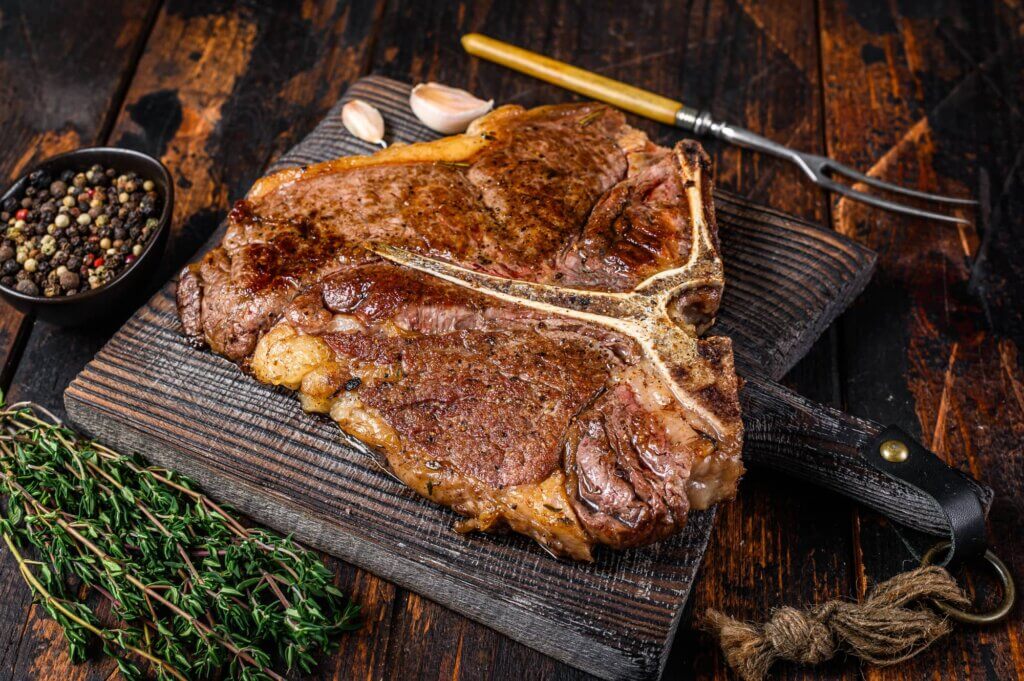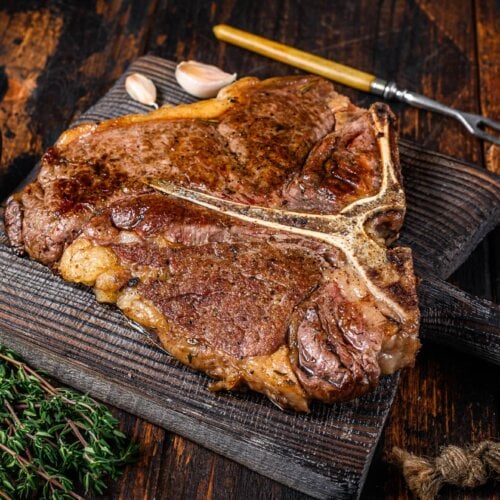
Porterhouse is, by far, one of the most eye-catching steaks you can put on your plate. That’s probably because it’s usually the size of a whole plate, leaving little room for anything else.
It’s also an interesting cut that includes two popular steaks in one — strip steak and tenderloin — giving you loads of flavor and an enticing texture in each bite. But, because of its dual-steak composition, it also requires a little extra care when cooking, regardless of whether you’re grilling, pan-searing, or oven baking.
Follow along with our guide to learn everything you need to know about how to cook porterhouse steak.
What is Porterhouse Steak
If you are familiar with a T-bone steak, then you’re familiar with a porterhouse steak — sort of. These two steaks are similar in that they contain the same cuts of beef. On one side of the bone that runs right through the middle is a strip steak; on the other side is the tenderloin.
However, the porterhouse is a bigger cut than the T-bone. The USDA actually sets guidelines that help distinguish between both cuts. A porterhouse’s tenderloin portion must be at least 1 ¼ inches thick to qualify as a porterhouse. Anything under that, and you’ve got yourself a T-bone.
These hefty cuts of beef can weight two pounds or more, making them excellent options for a steak meal for two (or three or four!). While usually served whole, they can also be trimmed off the bone and cut into separate steaks or sliced thinly for steak salads, sandwiches, and more.
What Cut of Beef is Porterhouse
Butchers cut porterhouse steak from the short loin, which sits just behind the ribs. The short loin is where the tenderloin reaches into. To cut a porterhouse, the butcher trims the short loin part that includes both the strip steak and tenderloin, leaving the attaching bone intact.
5 Ways to Cook Porterhouse Steak
Before cooking porterhouse with any method, salt it generously on both sides to create a brine that helps it crisp up with a nice sear. Let it sit at room temperature for 45 minutes before cooking.
Grilling Porterhouse Steak
- Preheat the grill to high, or about 450 degrees.
- Brush porterhouse steak with olive oil on both sides. Season with a little more salt and some freshly ground black pepper.
- Transfer steaks to the hottest area of the grill, and sear for 4-5 minutes.
- Use tongs to flip the filet to the other side, cooking for another 4-5 minutes until seared.
- Check the temperature. For medium-rare, it should be 120-125 degrees. If the steak needs a little more time, move it to a low-heat portion of the grill, close the lid, and cook for another 1-2 minutes.
- Rest for 5-10 minutes on a foil-tented plate before serving.
Pan-Seared Porterhouse Steak
- Preheat oven to 400 degrees.
- Heat one tablespoon of olive oil in a cast-iron skillet over medium-high heat. Then, season the steaks with a little more salt and some pepper, to taste.
- Sear porterhouse steak in the skillet for 2-3 minutes. Flip with tongs, and do the same to the other side.
- Check the internal temperature of the thickest part of the meat. For medium-rare, it should be 120-125 degrees. Reduce heat to low and cook for another 1-2 minutes if your steak needs more time to reach your desired doneness level.
- Transfer steaks to a plate tented with foil to rest for 5-10 minutes.
Cooking Porterhouse Steak in the Oven
- Preheat the oven to 425 degrees.
- Brush olive oil on steaks. Then, sprinkle with salt and pepper on both sides.
- In a heated cast-iron skillet, sear on each side for 1-2 minutes.
- Transfer the skillet to the oven to cook for another 5-10 minutes, depending on your desired level of doneness. Medium-rare steaks should read 120-125 degrees.
- Remove from oven and transfer the porterhouse steaks to a clean plate tented with aluminum foil. Rest for 5-10 minutes before enjoying.
Reverse Sear Method for Porterhouse
- Preheat oven to 250 degrees. Brush porterhouse steaks with olive oil, and sprinkle with a little salt and pepper on both sides.
- Transfer to a cast-iron skillet with a drizzle of olive oil. Cook for about 20-30 minutes, or until the internal temperature reads 120 degrees.
- Turn stove burner to medium-high. Sear steaks on each side for 1-2 minutes until a golden-brown crust forms.
- Place porterhouse steaks on a clean plate tented with foil to rest for 5-10 minutes.
Porterhouse Steak Sous Vide
- Preheat the water bath to 130 degrees.
- Season porterhouse steaks with salt and pepper. Add your choice of aromatics, like rosemary, garlic or thyme, to a sealable bag with the steaks.
- Vacuum seal the bag and add to the water bath, fully submerging the steaks.
- Cook for about one hour.
- Preheat a cast-iron skillet with a drizzle of olive oil over medium-high heat. Transfer the steaks to the skillet, and cook on each side for 1-2 minutes until seared.
- Place steaks on a foil-tented plate, and rest for 5-10 minutes.
Seasoning Porterhouse
A light seasoning of salt and pepper works well for porterhouse steak. Be sure to season both sides of the steak with as much salt and pepper as you’d like. You can also add a sprinkle of steak seasoning for extra flavor or some garlic powder, onion powder, or thyme. For something a little different, add a splash of Worcestershire sauce when pan-searing or brush the steaks with it when grilling.
Marinating Porterhouse Steak
Make a simple marinade for porterhouse steak with one part olive or cultured oil for a to two parts soy sauce, garlic cloves, pepper, and thyme. Marinate the steaks in the refrigerator for at least two hours, or preferably overnight. Allow to rest at room temperature for 20-30 minutes before cooking.

Grilled Porterhouse Steak
Ingredients
- 2 porterhouse steaks
- olive oil
- salt and ground black pepper, to taste
Instructions
- Remove porterhouse from the refrigerator and transfer to a clean plate or cutting board. Salt both sides generously and allow them to sit at room temperature for 45 minutes
- Preheat the grill to high heat
- Brush both sides of the steaks with olive oil. Then, season with salt and pepper to taste
- Add the steaks to the grill on its hottest part. Sear for 4-5 minutes until a golden-brown crust forms. Then, flip to the other side with tongs, searing for 4-5 minutes
- Check that the internal temperature is between 120-125 degrees for medium-rare (about 130 for medium). If not, move steaks to a low-heat area of the grill; cover, and cook for 1-3 more minutes
- Transfer steaks to a clean cutting board. Tent with foil and allow to rest for 5-10 minutes before serving
Grilled Porterhouse Steak – Nutritional Facts
Per 12 oz Cooked Steak (Based on a 2,000-Calorie Daily Diet)
| Nutrient | Amount (% DV) |
|---|---|
| Calories | 820 |
| Total Fat | 58g (74%) |
| Saturated Fat | 22g (110%) |
| Cholesterol | 190mg (63%) |
| Sodium | 400mg (17%) |
| Total Carbohydrate | 0g (0%) |
| Dietary Fiber | 0g (0%) |
| Sugars | 0g |
| Protein | 70g (140%) |
| Iron | 5.2mg (29%) |
| Vitamin C | 0mg (0%) |
| Calcium | 40mg (3%) |
| Potassium | 760mg (16%) |
Additional Information
To cook the best porterhouse steak at home, follow these extra tips.
Cooking Times
Porterhouse steak doesn’t take long to cook with its most popular cooking methods. Sous vide will take the longest, at about an hour and a half total to sous vide, sear, and rest the steaks. Set aside about 45 minutes to cook and rest a reverse-seared porterhouse steak. Grilling, pan-searing, and oven-cooking a porterhouse take less time, usually about 20-30 minutes total.
Measuring Doneness
Measuring the doneness of your porterhouse steak is the key to getting the finished product you were hoping for. Use a meat thermometer to take the temperature of the thickest part of your porterhouse steak. On this cut, that’s usually the tenderloin side of the bone. For a medium-rare cook, the thermometer should read 130-135 degrees after the steak rests for at least five minutes. Use our steak temperature guide for more help.
Conclusion: Your Guide to Cooking Porterhouse Steak
Shop porterhouse steak from Chicago Steak Company today to get quality, aged steaks delivered to your door. Our guide will help you learn to cook them, no matter which cooking method you prefer. If you have a grill, fire it up and try our simple grilled porterhouse steak recipe to mimic the steaks you’d get at your favorite steakhouse restaurant.

